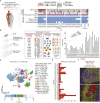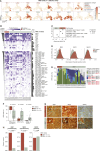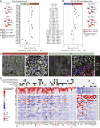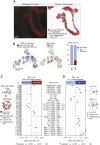Multiplexed Spatial Profiling of Hodgkin Reed-Sternberg Cell Neighborhoods in Classic Hodgkin Lymphoma
- PMID: 38949890
- PMCID: PMC11369618
- DOI: 10.1158/1078-0432.CCR-24-0942
Multiplexed Spatial Profiling of Hodgkin Reed-Sternberg Cell Neighborhoods in Classic Hodgkin Lymphoma
Abstract
Purpose: Classic Hodgkin lymphoma (cHL) is a B-cell lymphoma that occurs primarily in young adults and, less frequently, in elderly individuals. A hallmark of cHL is the exceptional scarcity (1%-5%) of the malignant Hodgkin Reed-Sternberg (HRS) cells within a network of nonmalignant immune cells. Molecular determinants governing the relationship between HRS cells and their proximal microenvironment remain largely unknown.
Experimental design: We performed spatially resolved multiplexed protein imaging and transcriptomic sequencing to characterize HRS cell states, cellular neighborhoods, and gene expression signatures of 23.6 million cells from 36 newly diagnosed Epstein-Barr virus (EBV)-positive and EBV-negative cHL tumors.
Results: We show that MHC-I expression on HRS cells is associated with immune-inflamed neighborhoods containing CD8+ T cells, MHC-II+ macrophages, and immune checkpoint expression (i.e., PD1 and VISTA). We identified spatial clustering of HRS cells, consistent with the syncytial variant of cHL, and its association with T-cell-excluded neighborhoods in a subset of EBV-negative tumors. Finally, a subset of both EBV-positive and EBV-negative tumors contained regulatory T-cell-high neighborhoods harboring HRS cells with augmented proliferative capacity.
Conclusions: Our study links HRS cell properties with distinct immunophenotypes and potential immune escape mechanisms in cHL.
©2024 The Authors; Published by the American Association for Cancer Research.
Conflict of interest statement
M. Roshal reports personal fees from Auron, grants from AstraZeneca, and grants and nonfinancial support from Genentech outside the submitted work. S.P. Shah reports grants from AstraZeneca and Bristol Myers Squibb during the conduct of the study. N.D. Socci reports grants from NIH during the conduct of the study. A. Dogan reports grants from Roche and AstraZeneca outside the submitted work. I.K. Mellinghoff reports grants from General Electric, Lilly, and Roche; grants and other support from Amgen, Kazia Therapeutics, Servier, and Agios; and other support from AstraZeneca outside the submitted work. No disclosures were reported by the other authors.
Figures





References
-
- Connors JM, Cozen W, Steidl C, Carbone A, Hoppe RT, Flechtner HH, et al. Hodgkin lymphoma. Nat Rev Dis Primer 2020;6:61. - PubMed
-
- Brice P, de Kerviler E, Friedberg JW. Classical Hodgkin lymphoma. Lancet 2021;398:1518–27. - PubMed
-
- Aoki T, Chong LC, Takata K, Milne K, Hav M, Colombo A, et al. Single-cell transcriptome analysis reveals disease-defining T-cell subsets in the tumor microenvironment of classic Hodgkin lymphoma. Cancer Discov 2020;10:406–21. - PubMed
MeSH terms
Grants and funding
LinkOut - more resources
Full Text Sources
Medical
Research Materials

